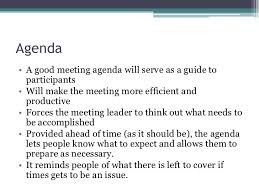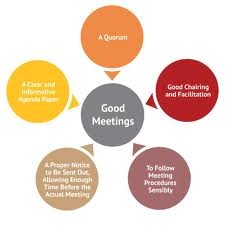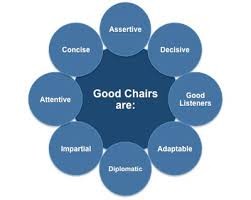Importance of agenda and minutes in meeting
 An Agenda is a schedule or list of items to be attended to in a meeting. The difference between meetings with and without agendas can mean chaos, tangled viewpoints, misunderstood norms and very few accomplishments. An agenda communicates to attendees that the meeting will be conducted in an orderly fashion and that productivity is the goal. Businesses hold meetings to achieve goals and get things done, share information, develop plans, document progress, provide precision and make decisions. An agenda can ensure that the meeting stays on track and that special projects and routine operations proceed as intended. An agenda can help the board of directors’ function as an effective team. Usually the Board Secretary, who is often the CFO, is responsible for organizing the Board meeting. The Secretary cannot be effective, however, without the active support of the CEO and the Board Chairman.
An Agenda is a schedule or list of items to be attended to in a meeting. The difference between meetings with and without agendas can mean chaos, tangled viewpoints, misunderstood norms and very few accomplishments. An agenda communicates to attendees that the meeting will be conducted in an orderly fashion and that productivity is the goal. Businesses hold meetings to achieve goals and get things done, share information, develop plans, document progress, provide precision and make decisions. An agenda can ensure that the meeting stays on track and that special projects and routine operations proceed as intended. An agenda can help the board of directors’ function as an effective team. Usually the Board Secretary, who is often the CFO, is responsible for organizing the Board meeting. The Secretary cannot be effective, however, without the active support of the CEO and the Board Chairman.
 A well planned agenda gives a greater sense of control. The agenda is often sent out in advance of the meeting so attendees know what to expect and have time to prepare their view points on action points. An agenda gives the person conducting the meeting control over the flow of discussions, the issues covered and the attendees responsible for reporting specific information at the meeting. An agenda also helps keep the meeting within a programmed time frame controlling when issues are discussed. People are less likely to slow the meeting with interruptions if they know that their issue is on the agenda. Each attendee can relax knowing that the meeting is under control and that issues that are important to each are listed on agenda.
A well planned agenda gives a greater sense of control. The agenda is often sent out in advance of the meeting so attendees know what to expect and have time to prepare their view points on action points. An agenda gives the person conducting the meeting control over the flow of discussions, the issues covered and the attendees responsible for reporting specific information at the meeting. An agenda also helps keep the meeting within a programmed time frame controlling when issues are discussed. People are less likely to slow the meeting with interruptions if they know that their issue is on the agenda. Each attendee can relax knowing that the meeting is under control and that issues that are important to each are listed on agenda.
An agenda increases productivity at meetings. Attendees of the meeting understand that all items on the agenda must be discussed and are likely to move at a pace that ensures they will cover everything. Agendas make it clear which items need action and who are the responsible people to take those actions. This allows attendees to leave meetings knowing what must be accomplished before the next meeting. The agenda also allows attendees to evaluate actions at the next meeting and receive progress report. The agenda helps attendees zero in on the areas where decisions are needed and clears the way for progress. Attendees can leave the meeting feeling relaxed and with sense of achievement with the agenda to verify their productivity.
 Agendas help in maintaining documentation. As meeting progresses, the person taking minutes notes on the agenda, the results of each discussion, which action items were completed or which are newly developed, reports given, issues to be resolved and other documentation of events at the meeting. The agenda notes help while creating minutes that match the flow of the meeting and also provide inclusive documentation of the meeting.
Agendas help in maintaining documentation. As meeting progresses, the person taking minutes notes on the agenda, the results of each discussion, which action items were completed or which are newly developed, reports given, issues to be resolved and other documentation of events at the meeting. The agenda notes help while creating minutes that match the flow of the meeting and also provide inclusive documentation of the meeting.
It is standard procedure in most workplaces to record everything that transpires in a meeting. The stupidest thing such as a spat or a quarrel also is recorded. Methods of record-keeping vary from organization to organization. But the most common method is having a secretary take notes. These notes which are called minutes, is usually first circulated in draft form so that all participants have the opportunity to check for accuracy and to make corrections if necessary. This ensures that all participants agree that the record is precise.
Minutes of the meeting: Are the well written record of meeting, particularly in board of directors and shareholders corporate meetings. The names of everyone in attendance at the meeting are usually the first things recorded, the names of absentees is also recorded. This serves two purposes: one, absent members can stay in the loop and keep abreast of what they missed at the meeting, and two, their absence from this meeting becomes part of the public record. If some participants regularly find ways to avoid meetings, they might be more reluctant to skip a future meeting when they realize their repeated absences have been noted.
We often see that human memory is fallible. Some participants are likely to have selective memories and forget whatever doesn’t validate their viewpoint; this particularly happens in case of contentious issues. An open record is a good idea and means to remind everyone what was agreed upon and why. It is especially important to have records to refer back to after a significant amount of time has passed and people are no longer sure what had emerged and why certain decisions were taken in a fashion. New managers find it helpful to review previous meeting minutes to quickly learn how the organization has been functioning and to detect patterns in behavior of the participants.
Recording a meeting and making the record available to absent participants in the meeting is a way to be more inclusive. Even though those absent participants might not have been able to provide their input during the meeting, they can still see how decisions were made. They will have some knowledge about the decision-making process and will know who the key decision makers were. They will be able to approach meeting participants and offer their point of view if they so choose to do so.
Minutes help in taking suitable actions. Meetings tend to become more efficient when participants are aware of their discussions being recorded; they are more likely to stay on topic. The minutes provide a record of decisions made and who is responsible for taking action. There is an increased chance that these actions will be carried out. Without a record, the participants might not remember who is responsible for the next step of the action plan and disputes might arise. With a public record to refer to, those responsible will be held accountable and expected to proceed as agreed. Unresolved issues won’t be forgotten and can be reopened at a successive meeting.
Knowledge of agenda and minutes of meeting helps in holding efficient and effective meetings. Good meeting in turn helps making projects successful. In a good meeting, participant’s ideas are heard, decisions are made through group discussion and with reasonable speed, and activities are focused on desired results. Good meetings help generate keenness in projects, help in building skills for future projects, and provide participants with techniques that may benefit them in their jobs.
 Good meetings require good leaders (chair) and good participants. A good leader understands the purpose of a meeting, he/she makes sure that all participants understand this purpose; it helps keep the discussion on track, and ensures that each participant is involved in discussions. A good leader works with participants to carry out the business of the meeting in the allotted time. These responsibilities require distributing an agenda, minutes of the previous meeting and other written materials prior to a meeting.
Good meetings require good leaders (chair) and good participants. A good leader understands the purpose of a meeting, he/she makes sure that all participants understand this purpose; it helps keep the discussion on track, and ensures that each participant is involved in discussions. A good leader works with participants to carry out the business of the meeting in the allotted time. These responsibilities require distributing an agenda, minutes of the previous meeting and other written materials prior to a meeting.
Good participants come to a meeting prepared for the business at hand; with reports ready, concerns over key issues thought out, and questions about key issues organized. They don’t come late for the meetings, they are in time. A good leader does not wait for latecomers. A good meeting starts in time and ends in time. Late entrants disturb the meeting during the middle of a coherent discussion. Good participants also bring to the table their best listening skills, manners and etiquettes and concise discussing manners. Good participants take turns while talking, stay on the point of discussion, and help to move decisions forward without any quarrels.
I want to quote here James T. Kirk’s thought on meeting in lighter vein “a meeting is an event where minutes are taken and hours wasted”.













































